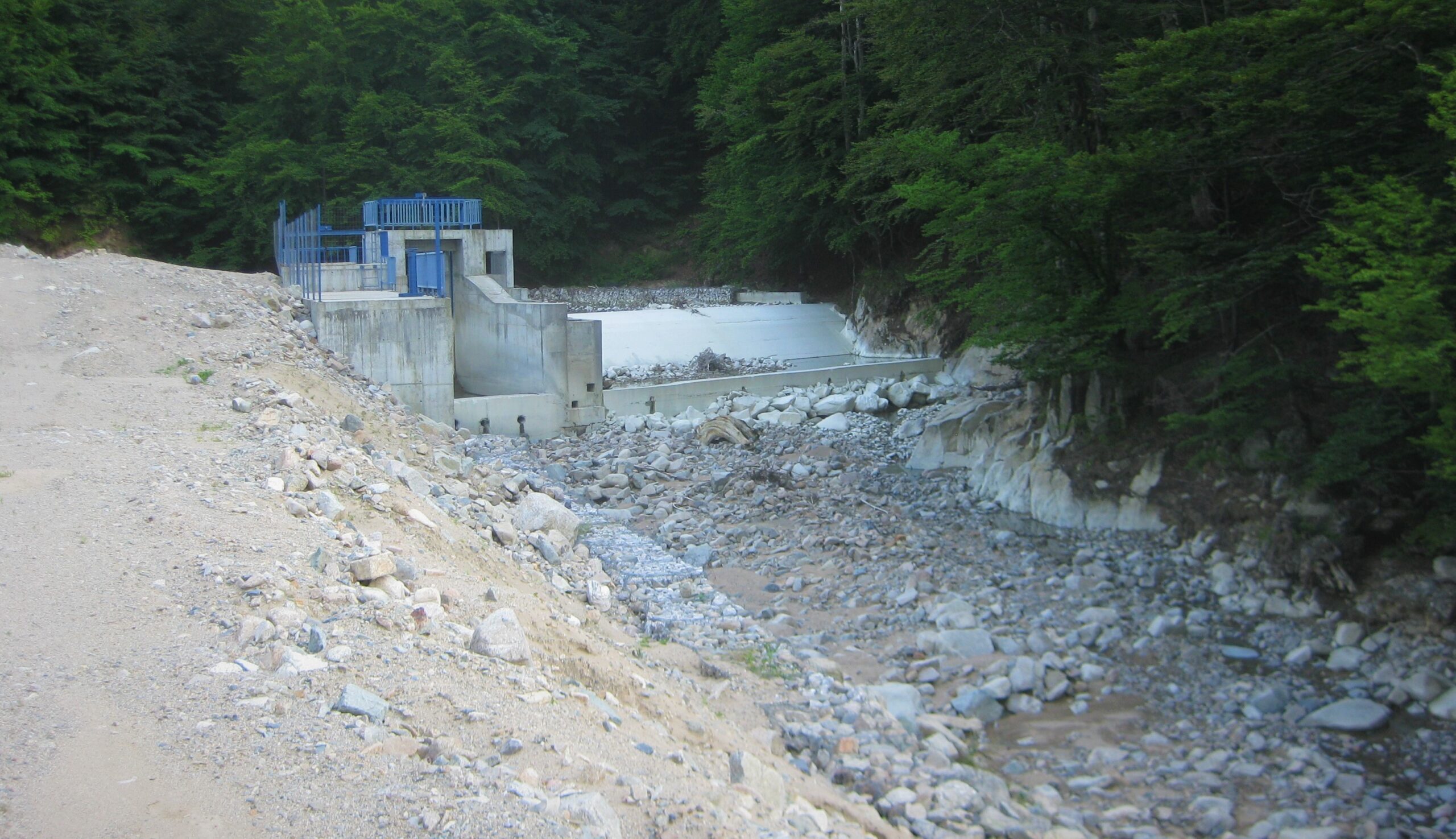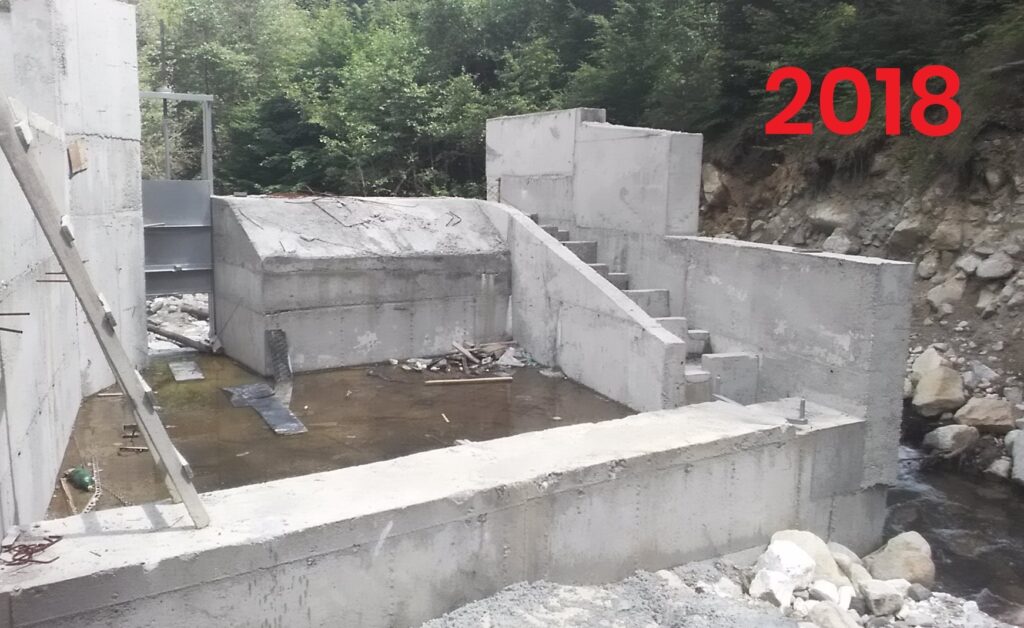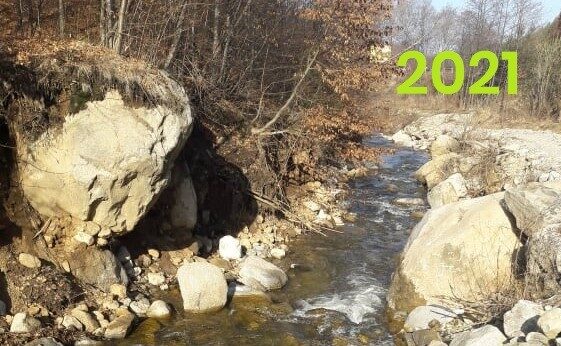EBRD and EIB investments in Bulgarian hydropower have once again been hit by scandal with the recent failure of the Chaira pumped storage plant and revelations about the illegality of small hydropower plants. The planned Yadenitsa dam would be more of the same: will the EBRD and EIB be wise enough to say no?
Andrey Ralev, Biodiversity Campaigner | 30 May 2022

The 0.6 megawatt Etropole hydropower plant built with financial support from the EBRD in the Central Balkan National Park buffer, July 2015, photo: Monitoring of existing HPP / sHPP in Bulgaria
There is a well-known phrase in Bulgarian: наливам от пусто в празно (to pour from empty into the void). As with many idioms, it is difficult to translate, but means doing something completely useless and unnecessary. This is unfortunately what comes to mind with regard to the vast majority of investments by the European Bank for Reconstruction and Development (EBRD) and the European Investment Bank (EIB) in the Bulgarian hydropower sector.
Recent incidents at the Chaira pumped storage hydropower plant
On 23 March 2022, during the testing of one of the two rehabilitated turbine units at Bulgaria’s Chaira pumped storage hydropower plant, the facility was destroyed by the force of the water. The unit had just been renovated via the EUR 37 million Project for Rehabilitation of Belmeken-Sestrimo-Chaira Hydro Power Complex. Implemented by the National Electric Company of Bulgaria (NEK EAD), the project is financed 70 per cent by the Kozloduy International Decommissioning Support Fund (KIDSF), administered by the EBRD.
Shortly after, on 4 May, the last working unit crashed and the 864 megawatt (MW) plant completely stopped working, with monthly losses for Bulgaria estimated at EUR 25 million.
Investigative journalists and even the new minister of the interior claim that the works might have been intentionally sabotaged via a fraud scheme, because when the Chaira plant is not working, other private power plants linked to former politicians Hristo Kovachki and Ahmed Dogan are used to balance the energy system and gain additional benefit and thus these politicians have a strong interest in the Chaira plant being offline. It is also notable that instead of asking Toshiba, the producer of the turbines, to carry out the rehabilitation, NEK EAD selected the companies ABB and VOITH, who obviously did not have sufficient experience in producing or rehabilitating this type of turbine.
This indicates that the EBRD did not carry out appropriate due diligence and monitoring when approving and disbursing funding to NEK EAD, which also suggests the Bank has inadequate control over procurement procedures. As a result, the largest pumped storage plant in southeast Europe is currently completely out of action.
Twenty years of illegal hydropower investments in Bulgaria
At least 29 new hydropower plants have been built in Bulgaria since 2005 with the support of the EBRD and EIB, more than half impacting Natura 2000 sites and other protected areas (see table at the end). Most of the plants were financed through Bulgarian commercial banks as intermediaries. The Blagoevgradska Bistritsa cascade, supported by the EBRD and EIB, has destroyed a river in Bulgaria by misusing the drinking water pipelines. The Svoghe cascade on the Iskar river, directly financed by the EBRD, was planned and partially built within the Vrachanski Balkan Nature Park in an unprecedented violation of article 33 of Bulgaria’s Protected Areas Act.
Moreover, 155 private hydropower plants in Bulgaria, including almost all of those financed by the EBRD and EIB, are illegal, as their intakes were built in riverbeds without permission from the state. According to article 11 of Bulgaria’s Water Act, the country’s riverbeds are considered public state property and to build anything on such property a special decision issued by the Council of Ministers under the Bulgarian State Property Act is required. Such a decision has only been issued for three private plants. All the others built in the riverbed are in violation of this act, as well as the Spatial Planning Act which stipulates in article 161 that: ‘[t]he developer is the owner of the property, the party to whom the right to build on someone else’s property has been established, or the party who has the right to build on someone else’s property by virtue of law.’
In 2021, for the first time, an illegal plant was removed from the river because the court annulled its construction permit. This opens a precedent for other similar plants, including those financed by the European public banks. This could represent a significant reputational risk for them and would once again prove that public money has been misused for projects that harm the environment and don’t produce electricity.


Hydropower intake on Elovitsa river removed in 2021, photos: Dimiter Koumanov and Ivan Mishev
Into the void (the Yadenitsa dam)
Nothing better fits the phrase ‘pouring from empty into the void’ than the project to build the Yadenitsa dam. Promoted as an important investment project by NEK EAD and Project of Common Interest of the EU, it is planned to increase the amount of water that the Chaira plant can pump up to the Belmeken reservoir by connecting the existing Chaira reservoir and a new Yadenitsa reservoir with a reversible 6,730-metre-long pressure tunnel. It was declared a project of national importance in 2012 and the preparatory works were co-financed with EUR 2.5 million from the EU Innovation and Networks Executive Agency (INEA).
Even before the failure of the Chaira pumped storage plant, the project was more than risky. The water from the new reservoir and tunnel would most likely be lost in the multiple tectonic cracks in the area. The dam wall is planned to be built just above the famous Yadenitsa seismic fault between the Rila and Rhodope Mountains, posing a threat to the people who live downstream, as the National Institute of Geophysics, Geodesy and Geography confirmed in 2017. Earthquakes can result in damage or failures for dam structures, while dams with large reservoirs can induce earthquakes.
Additionally, the project would have a significant impact on the Niska Rila Natura 2000 site, officially proposed in 2019. The impacts of additional water extraction and construction in the riverbed have not been assessed yet.
And last but not least, the Chaira plant would in any case need to be fixed before even thinking about the Yadenitsa dam, but it is anyway doubtful that the Yadenitsa dam would perform as planned, due to losing water through leakage.
In February 2022, the Minister of Finance Assen Vassilev announced in parliament that financing for the Yadenitsa dam had been secured from the EIB and EBRD. He claimed that:
‘The project for the expansion of the Chaira [pumped storage hydropower plant] will proceed. The reason why the project has not started yet is the huge number of environmental infringement procedures… which are currently blocking the project’.
In an answer to Bankwatch, the EBRD denied Vassilev’s claim but did not rule out future EBRD participation: ‘we can confirm that the EBRD has not approved any financing for the expansion of the Belmeken-Sestrimo-Chaira PSHPP, or construction of a Yadenitsa reservoir. Should potential EBRD participation in the project proceed beyond very early concept review discussions, all of EBRD’s various safeguard policies will apply – and need to be met – in full.’
According to government sources, in early 2022 experts from the EIB met with government representatives to discuss permitting procedures for the Yadenitsa dam.
The EIB and EBRD must learn from past mistakes
Both the EIB and EBRD have tightened their environmental and social standards regarding hydropower in recent years, so it is surprising that they would even consider financing the Yadenitsa dam. This project is incompatible with the banks’ rules due to the significant harm it would inflict on biodiversity as well as its threats to public safety.
Whatever phase the EBRD and EIB are in considering financing for the project, they must not pour more millions into the void. This extremely expensive project, which has risks for human safety and nature, would most probably not work as planned, and is promoted by the same National Electric Company which proved incapable of rehabilitating two old turbines, is a recipe for disaster.
Table: Small and medium-sized hydropower plants built with the financial support of the EBRD and EIB

Never miss an update
We expose the risks of international public finance and bring critical updates from the ground – straight to your inbox.
Institution: EBRD | EIB
Theme: Hydropower
Location: Bulgaria
Tags: Bulgaria | biodiversity | dam | hydropower
